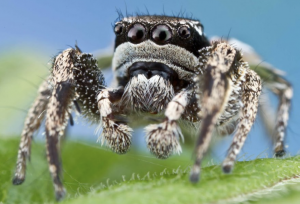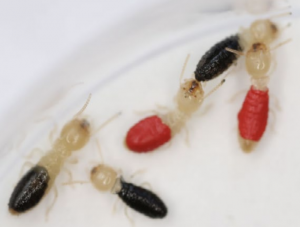Grocery shopping, while tedious at times, is relatively straightforward–the greatest danger is buying that tub of ice cream because of the enticing advertisements. But in the wild, knowing which meal to choose can be the difference between life and death. Jumping spiders are opportunistic predators, meaning that they hunt largely based on their environment and situation. Because they lack a go-to prey, there must be attuned to what prey are safe to eat and which ones may cause trouble.

Male Habronattus brunneus. Jumping spiders are opportunistic predators, and can hunt prey up to twice their size.
While some animals hide from predators through camouflage, others warn predators about the dangers of eating them by standing out from the environment. Known as aposematism, this defense mechanism typically takes the form of ‘advertising’ danger or unpleasantness using bright colors or obvious patterns–think poison dart frog or skunk. Researchers at the Universities of Florida and Auckland hypothesized that red-colored prey would deter jumping spiders from hunting them, and that spiders from different habitats would vary in their sensitivity to colorful danger signs.

Termites were painted either red or black to test whether spiders avoided or preferred certain colors of prey. Though more black termites were attacked, this study cannot discern whether this behavior is because of a true aversion to red or a preference for black.
To test whether the spiders preferred prey of a certain color, the researchers painted termites with either red or black paint. Red was chosen because, according to previous studies, spiders have the ability to see red (not all animals see the same color spectrum humans do). Furthermore, aposematic red prey are abundant in some, but not all, jumping spider habitats. Spiders were collected from regions both with and without danger-colored prey, and differences in prey choice were compared across all spiders and by region.

Left (a): Spiders generally were color-biased. Red termites were attacked far less than black termites. Right (b): UF organic garden and UF campus show significant color bias while Winter Park and Eastside High show no difference.
As the researchers predicted, significantly more spiders attacked the black termites than red termites. In addition, spiders from two out of four habitats rarely or never attacked red termites while spiders from the other two habitats attacked red ‘dangerous to eat’ termites almost equally as often as black ‘safe to eat’ termites.
So, how did some spiders know to avoid red prey and others didn’t? In order to explore this question, the researchers took soil samples, laid glue traps, and analyzed the grass, leaf, and soil cover at each spider habitat.
Though the data proved inconclusive, red-colored nontoxic insects (thrips and small wasps) were more abundant in habitats where the spiders showed no aversion to red prey. Moreover, the researchers found unpalatable red-colored insects in habitats from which native jumping spiders avoid red insects. This suggests that jumping spiders learn which prey to hunt based on their environment–if red prey usually signals a bad outcome, why would the spider risk it?
It’s only natural that we miss our mother’s home cooking. For jumping spiders and many other predators, using what is familiar to them may help them to avoid harm and survive to hunt another day.
References
Powell, E.C., Cook, C. Coco, J. et al. (2019). Prey color biases in jumping spiders (Habronattus brunneus) differ across populations. Ethology, 125, 351-361. Doi: 10.5061/dryad.3m24c84
